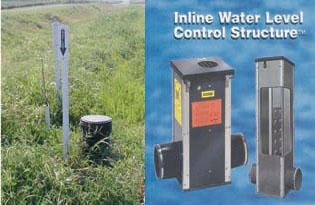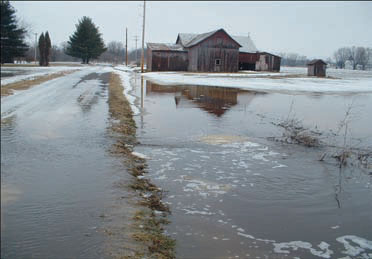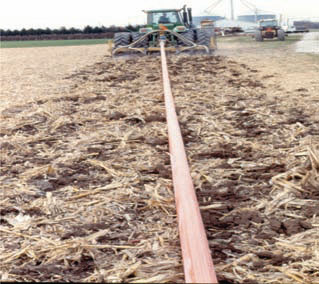Guidelines for Applying Liquid Animal Manure to Cropland with Subsurface and Surface Drains
Liquid animal manure is a valuable source of nutrients and organic matter for crop production and may be applied by a variety of methods including spray irrigation,land surface spreading, and shallow subsurface injection. Because of relatively low nutrient concentration, liquid animal manure may be applied at relatively high volumes, but it is generally recommended that it not be applied at rates that exceed the soil infiltration rate, nor exceed the amount needed to bring the soil to field water holding capacity (Johnson and Eckert, 1995). Even when similar guidelines are followed, liquid manure discharges from agricultural drains has been reported in soils with subsurface drainage due to macropore flow (Geohring et al., 2001). | Related: Manure & Nutrient Management in Tile Drained Lands…
Application of liquid animal manures to soils with subsurface drainage has been linked to contamination of the effluent with nutrients (Cook and Baker, 2001; Geohring et al., 2001), particulate organic matter (Barkle et al., 1999), estrogens (Burnison et al., 2003), bacteria (Bicudo and Goyal, 2003; Cook and Baker, 2001; Dean and Foran, 1992; Jamieson et al., 2002; Joy et al., 1998),and antibiotics (Kay et al., 2004). These findings are not universal, however, as liquid animal manures can be applied without any detectable adverse effects on water quality. For instance, Randall et al. (2000) noted no difference in nitrogen, phosphorus, or fecal indicator bacteria losses in drainage effluent when comparing plots fertilized with liquid dairy manure and mineral fertilizer.
|
Check Out These Programs & Research About Tile Drainage Swine Manure Timing & Subsurface Drainage Use of Filters in Drainage Control Structures |
The fact that liquid animal manure nutrients can be safely land recycled in some instances, but are discharged in subsurface drainage water under different circumstances, suggests a complex system that needs to be managed. Soil texture, available water holding capacity, tillage history, as well as the type and quantity of manure applied, application method, and timeliness of rainfall after application may all play a role in determining the fate of the manure.
Liquid Manure Applied to Subsurface-Drained Cropland
The available water holding capacity of the upper 8 inches of the soil provides an estimate of the maximum volume of water that can be applied before additional water, manure, and nutrients may begin to move through the soil profile (refer to Table 1). Manure application rates may need to be adjusted the day of application to avoid reaching the available water holding capacity of the soil and is one factor determining the maximum volume that should be applied. Application rates should not exceed the lower of the nutrient restriction, available holding capacity of the soil or 13,000 gallon/acre. Smaller multiple low applications allow the soil to absorb liquid animal manures better than one large application.
Suggestions To Minimize the Downward Movement of Liquid Manure
Have an Emergency Plan
Identify subsurface drain outlets, and control or regulate discharge prior to application, or have on-site means of stopping the discharge from subsurface drains. Subsurface drainage outlets should be monitored before, during, and after application for potential liquid manure discharge. Drainage control structures and inline tile stops are recommended control practices to reduce the risk of a discharge, while tile plugs may be used in emergency situations but have been known to fail (Hoorman, 2004). Use caution not to back-up water where it may impair the functioning of an adjacent subsurface drainage system. Develop a contingency plan to handle situations when liquid manure discharges to ditches or streams.
Select Low-Risk Areas
Liquid manure should not to be applied on soils that are prone to flooding, as defined by the National Cooperative Soil Survey (or in the Flooding Frequency Soil List posted in Section II eFOTG), during the period when flooding is expected. Manure can be applied if incorporated immediately or injected below the soil surface during periods when flooding is not expected.
Watch the Weather (Past and Future)
Avoid applying manure when rainfall is predicted, eminent, or directly after a rainfall event. After a significant rainfall event, the site should be allowed to drain to below field capacity, so that the soil has the capacity to absorb additional water or liquid animal manure. As part of the manure application record keeping, maintain a log of weather forecasts and actual weather conditions 24 hours before and after a manure application event.
Keep Drains Well-Maintained
Repair broken drains and blowholes prior to application, and follow recommended/required minimum setback requirements (setback distances vary from state to state) for surface inlets. See fact sheet on Liquid Manure Application Rates for Subsurface and Surface Drained Cropland in “Related Publications” section.
Are Drains Flowing?
Liquid manure should not be applied to subsurface drained cropland if the drains are flowing. Generally, flowing subsurface drain indicate soil moisture levels that are near or exceeding the soil water holding capacity. The addition of liquid manure under these conditions will increase the probability of manure moving downward and discharging through these drains or moving overland as surface runoff.
Consider Concentration of Application
Application rates should be closely tied to nutrient requirements and available holding capacity of the soil. The method of application can influence application rates. For example, with an injection toolbar with four nozzles on 30-inch spacing, each knife and nozzle produces a concentrated application to a small area. Under these concentrated flow conditions, the effective rate differs considerably from an average application rate. The effective rate is calculated as the volume of manure applied per unit area per nozzle. For example, assume a 10,000 gallon/acre application rate, an injection toolbar with 30-inch spacing and 6-inch sweeps, the effective rate is 50,000 gallon/acre, five times greater than a uniform even distribution over an acre.
Avoid Ponding
Liquid manure should be applied in a manner that will not result in ponding, or runoff to adjacent property, drainage ditches, or surface water regardless of crop nutrient need; and should be uniformly applied at a known rate. Liquid animal manure applications using irrigation or surface application equipment tend to have a greater risk of ponding.
Consider Tillage
Fields with a history of downward movement of manure and/or bare/crusted soils may require some tillage to improve infiltration and absorption of the applied liquid. Prior to manure application, use shallow tillage to disrupt the continuity of worm holes, macropores and root channels (preferential pathways) to reduce the risk of manure reaching drain lines, or till the surface of the soil 3 to 5 inches deep to a condition that will enhance absorption of the volume of liquid manure being applied. This is especially important if shallow drains are present (< 2 feet deep). Any pre-application tillage should leave as much residue as possible on the soil surface to minimize soil erosion.
Clay Soil Considerations
Clay soils with a high shrink swell capacity tend to have larger deeper cracks during dry conditions. These soils may require tillage to disrupt the cracks and macropores, and a lower initial application rate applied to the soil to help close the cracks. Cover crops may be planted to improve soil structure and absorb available manure nutrients. Determine the most limiting application rate based on the field conditions and nutrient limitations (may vary from state to state).
Depth of Injection
Shallow injection is recommended for liquid manure. Till the soil at least three inches below the depth of injection prior to application, and/or control outflow from all drain outlets prior, during, and after manure application.
Perennial Crop and No-Till Precautions
For perennial crops (hay or pasture) or continuous no-till fields where tillage is not recommended, all subsurface drain outlets from the application area should be monitored, and if manure laden flow should occur, all effluent should be captured. Crops with deep tap root systems (alfalfa) tend to have more problems than hay crops with fibrous roots (grass) because liquid animal manures may flow along the tap roots to subsurface drains and outlet to surface water.
These criteria may be waived if the producer can verify there is no prior history of manure discharge via subsurface drains, or if a system is in place to capture the discharge. However, if there is a discharge, the producer is liable for damages and is subject to being classified as a Concentrated Animal Feeding Operation (CAFO).
Liquid Manure Applied to Systematic Surface Drained Fields
Fields or areas of fields that have systematic “surface drainage” systems e.g., shallow surface drains spaced 100 to 200 feet apart—NRCS Surface Drainage-Field Ditch Practice Standard 607) are considered concentrated flow areas. However, if special precautions are taken, manure can be applied in the surface drains with minimal risk of surface runoff. This does not apply to the collector surface drains (mains, ditches, etc.) or drains bordering the fields.
The following special manure application techniques shall be used:
- Till the soil surface at least 3 to 5 inches deep prior to liquid manure surface application. Pre-till within 7 days of application.
- Surface-apply liquid manure uniformly over the entire soil surface on the freshly tilled soil (3 to 5 inches) to allow the liquid manure to be absorbed into the soil surface.
- For fields with no subsurface drainage, liquid manure can be injected directly without prior tillage. If subsurface drainage is present as well as surface drains, then the above recommendations for subsurface drained cropland apply as well.
d. Manure application rates should be adjusted to consider the most limiting factor and include the ability of the soil to accept, store and hold liquid manure, water, and nutrients.
Follow recommended/required setbacks from environmentally sensitive areas for surface inlets. See fact sheet on Liquid Manure Application Rates for Subsurface and Surface Drained Cropland.
Summary
Improved management is a key issue in greatly reducing the potential of liquid manure reaching our surface water. While climate and some environmental conditions cannot be controlled, producers can better manage and control when and how they apply liquid manure. These recommended practices are intended to help producers apply liquid manure in a manner that minimizes the potential to impact water resources through the downward movement of manure into subsurface (tile) drains. These recommendations incorporate the best available knowledge.
Acknowledgments
The authors acknowledge Dr. Harold Keener, The Ohio State University; Dr. Timothy H. Harrigan and Dr. William G. Bickert, Michigan State University; Michael J. Monnin and Frank E. Gibbs, Ohio Natural Resources Conservation Service, and Susanne R. Reamer and Michael I. Gangwar, Michigan Natural Resources Conservation Service, team members who helped organize and conduct the “Liquid Animal Manure Application on Drained Cropland: Preferential Flow Issues and Concerns Workshop” and reviewed the regional guidelines. The workshop was organized and sponsored by The Ohio State University, Michigan State University, and cooperating organizations, with partial support from the USDA–CSREES Great Lakes Regional Water Quality Program, USDA–Natural Resources Conservation Service, Ohio Compost and Manure Management, Ohio State University Extension, Great Lakes Basin: Soil Erosion and Sediment Control, and the Overholt Drainage Education and Research Program.
References
- Barkle, G.F., T.N. Brown, and D.J. Painter. 1999. Leaching of particulate organic carbon from land-applied dairy farm effluent. Soil Science 164 (4): 252–263.
- Bicudo, J.R., and S.M. Goyal. 2003. Pathogens and manure management systems: A review. Environmental Technology 24 (1): 115–130.
- Burnison, B.K., A. Hartmann, A. Lister, M.R. Servos, T. Ternes, and G. Van Der Kraak. 2003. A toxicity identification evaluation approach to studying strogenic substances in hog manure and agricultural runoff. Environmental Toxicology and Chemistry 22 (10): 2243–2250.
- Cook, M.J., and J.L. Baker. 2001. Bacteria and nutrient transport to tile lines shortly after application of large volumes of liquid swine manure. Transactions of the American Society of Agricultural Engineers 44 (3):495–503.
- Dean, D.M., and M.E. Foran. 1992. The effect of farm liquid waste application on tile drainage. Journal of Soil and Water Conservation 47 (5): 368–369. *Geohring, L.D., O.V. McHugh, M.T. Walter, T.S. Steenhuis, M.S. Akhtar, and M.F. Walter. 2001. Phosphorus transport into subsurface drains by macropores after manure applications: Implications for best manure management practices. Soil Science 166 (12):
- Hoorman, J.J. 2004. Ohio liquid manure violation water quality data, Ohio Journal of Science, Vol. 104, No. 1, A-34.
- Hoorman, J.J., J.N. Rausch, T.M. Harrigan, W.G. Bickert, M.J. Shipitalo, J.R. Reamer, F.E. Gibbs, M.J. Gangwar, and L.C. Brown. 2005. Summary of education and research priorities for liquid manure application to drained cropland: preferential flow issues and concerns, ASAE Meeting, Paper No: 52062. Tampa Bay, FL.
- Jamieson, R.C., R.J. Gordon, K.E. Sharples, G.W. Stratton, and A. Madani. 2002. Movement and persistence of fecal bacteria in agricultural soils and subsurface drainage water: A review. Canadian Biosystems Engineering 44: 1.1–1.9.
- Johnson, J., and D. Eckert. 1995. Best management practices: Land application of animal manure. Ohio State University Extension Publication AGF-208-95 Available online at http://ohioline.osu.edu/agf-fact/0208.html (Verified 8 September 2004).
- Joy, D.M., H. Lee, C.M. Reaume, H.R. Whiteley, and S. Zelin. 1998. Microbial contamination of subsurface tile drainage water from field applications of liquid manure. Canadian Agricultural Engineering 40 (3):153–160.
- Kay, P., P.A. Blackwell, and A.B.A. Boxall. 2004. Fate of veterinary antibiotics in a macroporous tile drained clay soil. Environmental Toxicology and Chemistry 23 (5): 1136–1144.
- Randall, G.W., T.K. Iragavarapu, and M.A. Schmitt. 2000. Nutrient losses in subsurface drainage water from dairy manure and urea applied for corn. Journal of Environmental Quality 29 (4): 1244–1252.
- Rausch, J.N., J.J. Hoorman, T.M. Harrigan, W.G. Bickert, M.J. Shipitalo, J.R. Reamer, F.E. Gibbs, M.J. Gangwar, and L.C. Brown. 2005. Guidelines for liquid manure application on drained cropland, ASAE Meeting, Paper No: 52061. Tampa Bay, FL.
Related Publications
-
-
- Ohio State University Extension, Ohio Livestock Manure Management Guide, Bulletin 604.
- Liquid Manure Application Rates for Subsurface and Surface Drained Cropland. USDA, Natural Resources Conservation Service, Practice Standard 633, Waste Utilization
- Livestock and Poultry Environmental Stewardship (LPES) Curriculum
- https://extensionpubs.unl.edu/publication/9000016364607/application-of-liquid-animal-manures-using-center-pivot-irrigation-systems/
- http://www.ext.colostate.edu/pubs/crops/04700.html
Authors
- James J. Hoorman, Water Quality & Cover Crops Extension Educator, Celina, OH <hoorman1@osu.edu>
- Jonathan N. Rausch Extension Program Director Food, Agricultural, and Biological Engineering <rausch.7@osu.edu>
- Larry C. Brown, Ph.D. Professor, Agricultural Water Management, Extension Agricultural Engineer Food, Agricultural, and Biological Engineering <brown.59@osu.edu>
This page was developed by Amanda Meddles, Extension Program Coordinator Environmental Management <meddles.14@osu.edu>
This page was adapted from Ohio State University Fact Sheet ANR-21-09 “Guidelines for Applying Liquid Animal Manure to Cropland with Subsurface and Surface Drains“
-









